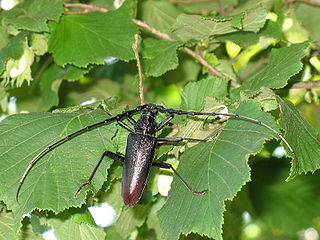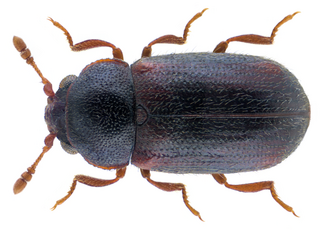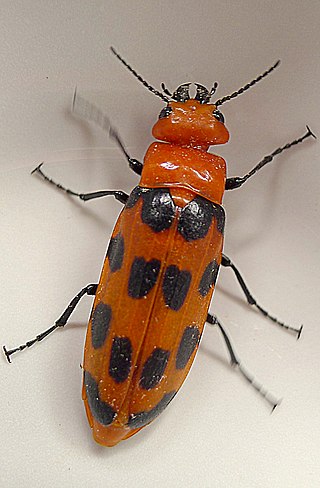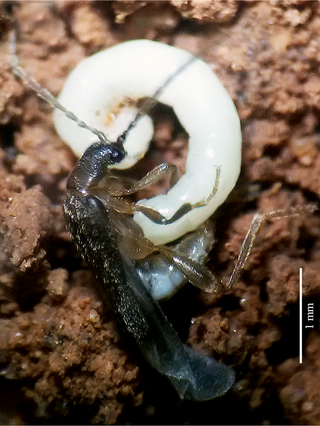
Stag beetles are a family of about 1,200 species of beetles in the family Lucanidae, currently classified in four subfamilies. Some species grow to over 12 centimetres, but most to about 5 cm (2 in).

The longhorn beetles (Cerambycidae), also known as long-horned or longicorns, are a large family of beetles, with over 35,000 species described.

Lucanus cervus, known as the European stag beetle, or the greater stag beetle, is one of the best-known species of stag beetle in Western Europe, and is the eponymous example of the genus. L. cervus is listed as Near Threatened by the IUCN Red List.

Cerambyx is a genus of beetles in the family Cerambycidae. They are commonly known as capricorn beetles, as their strong, stout and curved antennae, each segment of which flares towards the tip, are reminiscent of the horns of an Alpine Ibex or "capricorn".

Sphindidae is a family of beetles, in the suborder Polyphaga. They are called slime mold beetles due to their exclusive feeding on slime molds during adult and larval stages, other aspects of their life history are obscure. Palaeontological discoveries since 2015 have added to the geologic history of Sphindidae, including the discovery of Libanopsis, placed in the extinct subfamily Libanopsinae.

Byturidae, also known as fruitworms, are small family of cleroid beetles with over 15 described species, primarily distributed in the Holarctic and Southeast Asia. The larvae of at least some genera feed on fruit, such as Byturus, a notable commercial pest of Rubus consuming both the fruit and seeds, while others like Xerasia are associated with catkins. The adults are known to feed on developing leaves, flowers and pollen.
Trachelostenus is a genus of darkling beetles in the family Tenebrionidae. It is native to the Valdivian forests of Chile, and has at least two species, T. inaequalis (Solier) and T. fascicularis (Philipp). It was historically considered the only member of the family Trachelostenidae, but a 2015 study sunk the genus into the tenebrionid subfamily Tenebrioninae.

Carabinae is a subfamily of ground beetles in the family Carabidae, containing ten genera and over fourteen hundred described species. It has two tribes, the Cychrini Laporte (1834) and Carabini Latreille (1802). The latter is divided into two subtribes, the Carabina Latreille (1802) and Ceroglossina Vacher de Lapouge (1927).
Euzona is a genus of tiger beetles found in Australia. It was formed from the breakup of the Cicindela genus, and just like Cylindera, is in a state of dispute. Scientists do not agree whether the genus should be considered as a subgenus of Cicindela or kept in its current taxonomic rank. The genus contains the following species:

Bimiini is a tribe of beetles in the subfamily Cerambycinae, containing the following genera and species:

Criodion is a genus of Long-Horned Beetles in the beetle family Cerambycidae. There are about 11 described species in Criodion.
Plocaederus is a genus of Long-Horned Beetles in the beetle family Cerambycidae. This genus has a single species, Plocaederus bellator. It is known from the South American countries Brazil, Ecuador, Guyana, French Guiana, Paraguay, and Suriname.
Aleiphaquilon is a genus of Long-Horned Beetles in the beetle family Cerambycidae. There are about nine described species in Aleiphaquilon, found in South America.
Xyloterinus is a genus of typical bark beetles in the family Curculionidae. This is a monotypic genus and the one described species is Xyloterinus politus. It is native to North America where it infests both hardwood and softwood trees, as well as stacks of logs.

Ochthebius is a genus of minute moss beetles in the family Hydraenidae. There are at least 460 described species in Ochthebius.

Thanatophilus is a genus of carrion beetles in the family Silphidae. There are about 12 described species in Thanatophilus.

Paranaemia is a genus of lady beetles in the family Coccinellidae. There is one described species in Paranaemia, P. vittigera, the broad-striped lady beetle. The broad-striped lady beetle is native to western North America. Like other ladybugs, it preys on aphids.
Herthania is a genus of marsh beetles in the family Scirtidae. There are at least seven described species in Herthania.

Cissites is a genus of blister beetles in the family Meloidae. There are at least four described species in Cissites.

Jurasaidae is a family of elateroid beetles known from around a half-dozen species in two genera found the Brazilian Atlantic rainforest including drier transitional areas bordering the Caatinga. All known species have neotenic larva-like females and normal males, similar to some other elateroids. They occur in the soil horizon immediately under leaf litter, with the larvae likely being fungivorous, consuming the fluids of fungal hyphae.













